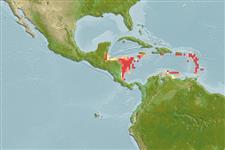>
Blenniiformes (Blennies) >
Chaenopsidae (Pike-, tube- and flagblennies)
Etymology: Acanthemblemaria: Greek, akantha = thorn + Greek, emblema, -atos, anything that is nailed, knocked in; also anything with bass or high relief (Ref. 45335).
Eponymy: Mrs Mary George, whom Böhlke extolled as “…my secretary for the past five years and now parent and housewife, in appreciation of her assistance in all the activities of the department during that period.” (Ref. 128868), visit book page.
Environment: milieu / climate zone / εύρος βάθους / distribution range
Οικολογία
Θαλασσινό(ά) Υφαλόφιλο(α). Tropical; 18°N - 10°N, 90°W - 58°W (Ref. 56273)
Western Central Atlantic: Bahamas (Ref. 5521) to Tobago.
Μέγεθος / Βάρος / Age
Γεννητική Ωρίμανση: Lm ? range ? - ? cm
Max length : 5.1 cm TL αρσενικό/απροσδιόριστο; (Ref. 5521)
Εδρικές άκανθες: 2. Species distinguished by: sides of body with series of dark bands or large oval blotches; top of head often spiny; patch of cranial spines on nape extends posterior to supratemporal commissural pore, almost to dorsal-fin origin; inner rim of posterior infraorbital bone spinous or with tuberculate spines; two or more rows of teeth on each palatine bone; dorsal fin consisting of spines and segmented rays; total dorsal-fin elements 29 to 40. Common amongst Chaenopsids: small elongate fishes; largest species about 12 cm SL, most under 5 cm SL. Head usually with cirri or fleshy flaps on anterior nostrils, eyes, and sometimes laterally on nape; gill membranes continuous with each other across posteroventral surface of head. Each jaw with canine-like or incisor-like teeth anteriorly; teeth usually also present on vomer and often on palatines (roof of mouth). Dorsal-fin spines flexible, usually outnumbering the segmented soft rays (numbering 7 to 37), spinous and segmented-rayed portions forming a single, continuous fin; 2 flexible spines in anal fin; pelvic fins inserted anterior to position of pectoral fins, with 1 spine not visible externally and only 2 or 3 segmented (soft) rays; all fin rays, including caudal-fin rays, unbranched (simple). Lateral line absent. Scales absent (Ref.52855).
Body shape (shape guide): elongated.
Inhabits limestone slopes rather than patch reefs and these slopes are usually dotted with small brain corals, stinging coral, sea fans, whips, and sea urchins (Ref. 5521).
Life cycle and mating behavior
Γεννητική Ωρίμανση | Αναπαραγωγή | Γεννοβολία | Αβγά | Γονιμότητα | Προνύμφες
Böhlke, J.E. and C.C.G. Chaplin, 1993. Fishes of the Bahamas and adjacent tropical waters. 2nd edition. University of Texas Press, Austin. (Ref. 5521)
IUCN Red List Status (Ref. 130435: Version 2025-1)
Threat to humans
Harmless
Human uses
Εργαλεία
Special reports
Download XML
Διαδικτυακές πηγές
Estimates based on models
Preferred temperature (Αναφ.
123201): 27.4 - 28.4, mean 28 °C (based on 142 cells).
Phylogenetic diversity index (Αναφ.
82804): PD
50 = 0.5000 [Uniqueness, from 0.5 = low to 2.0 = high].
Bayesian length-weight: a=0.00525 (0.00219 - 0.01260), b=3.06 (2.85 - 3.27), in cm total length, based on LWR estimates for this (Sub)family-body shape (Ref.
93245).
Τροφικό Επίπεδο (Αναφ.
69278): 3.4 ±0.4 se; based on size and trophs of closest relatives
Fishing Vulnerability (Ref.
59153): Low vulnerability (10 of 100).
🛈
Nutrients (Ref.
124155): Calcium = 190 [92, 371] mg/100g; Iron = 0.925 [0.518, 1.663] mg/100g; Protein = 18 [17, 19] %; Omega3 = 0.104 [0.051, 0.203] g/100g; Selenium = 17.5 [7.4, 42.4] μg/100g; VitaminA = 384 [117, 1,309] μg/100g; Zinc = 2.31 [1.44, 3.49] mg/100g (wet weight);
